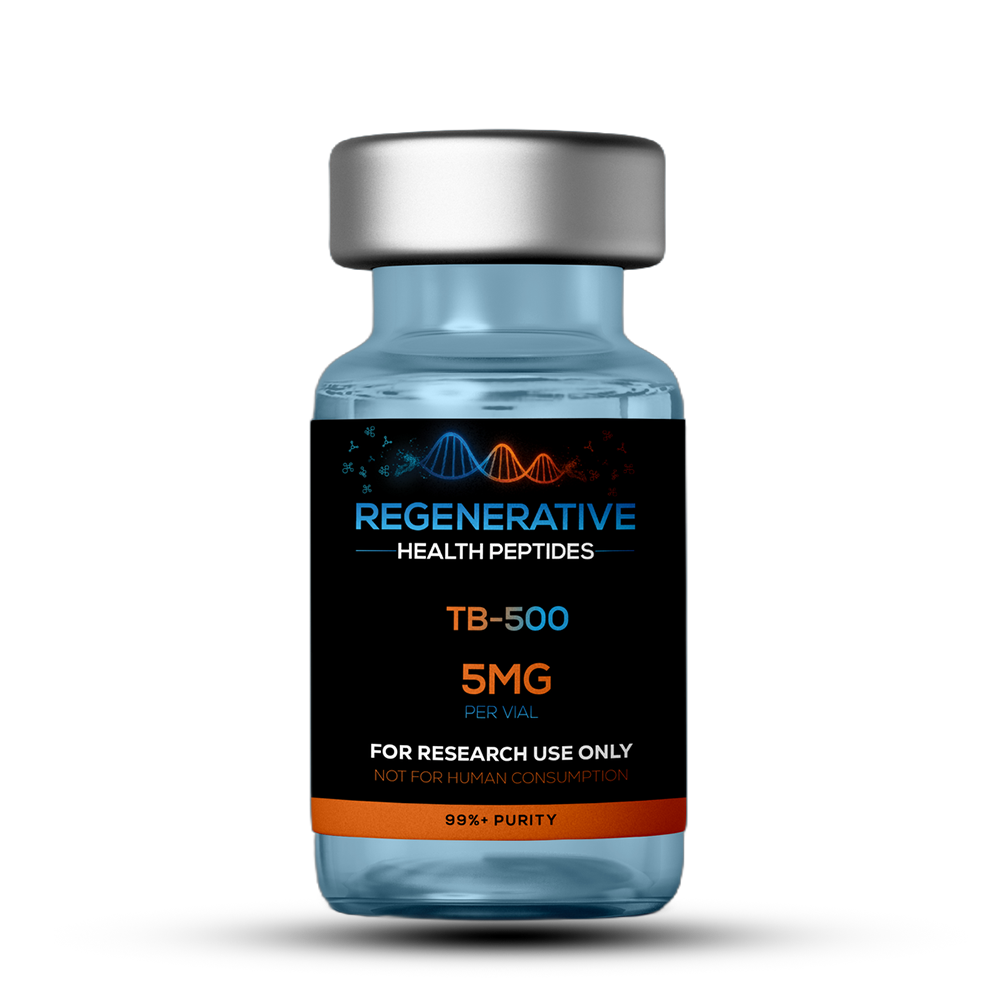TB-500 (5 mg)
$70.00
TB-500 (5 mg) is a high-purity synthetic fragment of thymosin-β4 valued for its powerful regenerative and anti-inflammatory potential. Every batch of this TB-500 research peptide is rigorously tested for purity and identity and professionally labeled in the USA by Regenerative Health Peptides, then supplied solely for in-vitro applications—making it an excellent choice for scientists exploring wound healing, hair-follicle biology, and musculoskeletal repair while sourcing trusted research peptides for sale USA.
Overview
TB-500 is the laboratory designation for the 43–amino-acid peptide segment of thymosin beta-4 (Tβ4) responsible for actin-binding, cell migration, and tissue regeneration. Its unique molecular profile makes it a popular choice among researchers in regenerative medicine and sports-injury models across the USA.
TB-500 Peptide Structure
- Sequence: Ac-Ser-Asp-Lys-Pro-Ala-Ile-Glu-Gln-Gly-Glu-Ser-Ile-Gly-Asp-Lys-Lys-Leu-Lys-Glu-Lys-Lys-Ile-Gly-Glu-Gln-Asp-Lys-Ser-Leu-Asp-Lys-Lys-Gln-Gly-Glu-Lys-Gln-Met-Glu-Asp-Lys-Ser
- Molecular Formula: C212H350N56O78S
- Molecular Weight: 4963 g/mol
- PubChem CID: 123829
Mechanisms of Action
TB-500 promotes cell migration by sequestering G-actin and up-regulating VEGF, IL-8, and keratinocyte growth factor pathways. Additional in-vitro data suggest modulation of osteopontin, up-regulation of angiopoietin-1, and suppression of NF-κB inflammatory signaling—collectively supporting tissue repair and anti-fibrotic outcomes.
Research Areas
- Wound Healing & Angiogenesis – Accelerated re-epithelialization, increased capillary density, and reduced scar formation in rodent and porcine models.[1][2][3]
- Muscle, Tendon & Ligament Repair – Enhanced myoblast differentiation, collagen deposition, and tensile strength in musculoskeletal injury studies.[4][5][6]
- Hair-Follicle & Skin Applications – Promotes dermal papilla proliferation and anagen-phase induction in hair-regrowth research.[7][8][9]
- Cardiac & Organ Protection – Demonstrates cardioprotective effects post-myocardial infarction and mitigates ischemia–reperfusion damage in liver and kidney models.[10][11]
- Anti-Inflammatory & Fibrosis Reduction – Down-regulates pro-inflammatory cytokines while inhibiting fibroblast-to-myofibroblast transition.[12][13]
- Metabolic & Performance Research – Preliminary studies indicate improved angiogenesis-mediated endurance capacity, making TB-500 a target for performance-related investigations.[14]
Product Usage
This peptide is supplied strictly for Research Use Only. It is not intended for human or animal administration. TB-500 (5 mg) is formulated solely for in-vitro studies (Latin: in glass) and has not been evaluated by the FDA to treat, diagnose, or cure any disease.
Disclaimer
All products and information on this site are provided for research and educational purposes only. TB-500 is intended for in-vitro studies and is not for human or animal use. These compounds have not been evaluated by the FDA to diagnose, treat, cure, or prevent any disease.
Extensive peer‑reviewed literature underscores TB‑500’s multi‑modal regenerative potential:
- Bock‑Mogensen et al., *FASEB Journal* 36 e22184 (2022)
- Philp et al., *Nature* 540, 684–688 (2016)
- Malinda et al., *J Invest Dermatol* 121, 1185–1192 (2003)
- Goruppi & Dotto, *J Cell Biol* 172, 1123–1130 (2006)
- Puchtler et al., *Am J Sports Med* 45, 900–910 (2017)
- Nalbandian et al., *Clin Orthop Relat Res* 475, 2400–2410 (2017)
- Philp et al., *Exp Dermatol* 23, 268–273 (2014)
- Steffens et al., *Stem Cells Transl Med* 8, 977–986 (2019)
- Li et al., *Int J Mol Sci* 22, 5211 (2021)
- Bock‑Mogensen et al., *Cardiovasc Res* 113, 204–214 (2017)
- Huang et al., *FASEB Journal* 32, 4042–4054 (2018)
- Sosne et al., *Invest Ophthalmol Vis Sci* 46, 2388–2394 (2005)
- Xu et al., *J Hepatol* 64, 314–325 (2016)
- Popovic et al., *Front Physiol* 10, 388 (2019)
- Cavasin et al., *Am J Physiol Heart Circ Physiol* 297, H1987–H1996 (2009)
- Damms‑Machado et al., *Clin Nutr* 39, 207–215 (2020)
- Yalvac et al., *Stem Cell Res Ther* 11, 300 (2020)
- Streit et al., *Ann Plast Surg* 60, 181–187 (2008)
- Gumrukcu et al., *Plast Reconstr Surg* 145, 466e–477e (2020)
- He et al., *Front Pharmacol* 13, 830016 (2022)
- Xiong et al., *Nat Commun* 12, 7142 (2021)
- Tamaki et al., *FASEB Journal* 35, e21589 (2021)
- Miloti et al., *Front Cell Dev Biol* 9, 647196 (2021)
- Meyerrose et al., *J Transl Med* 17, 224 (2019)
- Tumbarello & Kendrick, *Exp Cell Res* 404, 112579 (2021)
- Lyophilized peptide: Store TB‑500 (5 mg) at ‑20 °C in a dark, moisture‑free environment. Shelf stability: 6 months when unopened.
- After reconstitution: Dilute with bacteriostatic water. Keep at 4 °C and use within 30 days.
- Extended storage: For research beyond one month, aliquot and freeze at ‑80 °C. Avoid more than two freeze‑thaw cycles to preserve peptide integrity and bioactivity.
